S@SThom.as
Secai Marche, a farm-to-table fulfillment platform serving farmers in Japan and Southeast Asia, announced today it has raised 210 million Japanese yen (about $1.6 million USD) in Series A funding. The round included participation from venture capital firm The Agribusiness Investment and Consultation Co., Spiral Ventures Asia Fund I and Beyond Next Ventures.
This brings the startup’s total raised so far to $4.5 million. TechCrunch last covered Secai Marche when it raised seed funding from Rakuten and Beyond Next in 2021.
Since its seed funding, Secai Marche has built out its warehouse management and fulfillment system for perishables and established a cold supply chain from farm to end-users that covers over 300 farmers. Founder Ami Sugiyama told TechCrunch that by optimizing its supply chain and minimizing lead time for deliveries, Secai Marche is able to maintain a wastage rate of less than 1%.
Sugiyama said that the food service distribution industry in Southeast Asia is very large but highly-fragmented and inefficient. Secai Marche helps smooth bumps along the F&B supply chain with its in-house software, like a warehouse management system and demand forecast for perishable items. Over 4,000 items are available on the platform from farmers in Southeast Asia and Japan, including vegetables, fruit, eggs and seafood. They sell to more than 500 retailers and HORECA (hotels, restaurants and catering) customers.
Other farm-to-table startups in Southeast Asia that have raised funding over the last few years include Eden Farm, Kamereo and FreshKet.
Secai Marche strives to differentiate from other farm products wholesale platforms by providing an end-to-end fulfillment solution open to all farmers, which means it carries a wider variety of products, and providing more transparency
The funding will be used to develop Secai Marche’s demand forecast system and optimize truck routing as it expands its service areas.
Southeast Asia farm-to-table startup Secai Marche raises Series A by Catherine Shu originally published on TechCrunch
Welcome back to This Week in Apps, the weekly TechCrunch series that recaps the latest in mobile OS news, mobile applications and the overall app economy.
Global app spending reached $65 billion in the first half of 2022, up only slightly from the $64.4 billion during the same period in 2021, as hypergrowth fueled by the pandemic has decreased. But overall, the app economy is continuing to grow, having produced a record number of downloads and consumer spending across both the iOS and Google Play stores combined in 2021, according to the latest year-end reports. Global spending across iOS and Google Play last year was $133 billion, and consumers downloaded 143.6 billion apps.
This Week in Apps offers a way to keep up with this fast-moving industry in one place with the latest from the world of apps, including news, updates, startup fundings, mergers and acquisitions, and much more.
Do you want This Week in Apps in your inbox every Saturday? Sign up here: techcrunch.com/newsletters
Top Stories
Twitter gets editable… do we still care?
After years of user demand for an edit button, Twitter’s news this week that such a feature was now entering testing felt a little anticlimactic.
Twitter broke its own embargo over the impending launch. There weren’t any interviews. Instead, Twitter just casually noted the edit feature was being tested internally, it said in a tweet published ahead of its blog post announcement. Here’s a feature you wanted. I guess we’ll ship it.
And though the feature will roll out to users later this month, it won’t be broadly available. Instead, users can pay for a Twitter Blue subscription to access the edit feature, Twitter said. But only “some” Twitter Blue subscribers will even see the option, as it will still be in a test mode at first. Then there’s the fact that Twitter Blue subscribers have already been somewhat placated by the “Undo Tweet” feature — an option that lets you quickly unsend a tweet when you spot a typo. (It’s actually a delay to post, which makes the “unsending” possible.) This reduces the need for an edit button in many cases, as it turns out.
A true edit feature, meanwhile, introduces a layer of complexity on top of the increasingly cluttered social app. Although Twitter says the feature will have an edit log to minimize abuse, there’s concern that people will re-write tweets knowing that many won’t ever look at the past versions.
If anything, the demand for an edit button had become more a meme than a true user request. It was just sort of unfathomable to some Twitter users that a basic feature like this was not being built. But over the years, people have learned to work around the lack of editing. We’d delete and retweet things. We’d reply with a correction, cursing the lack of an edit button as we did. And then we moved on. Now Twitter wants everyone to pay for this long-requested functionality? Ouch.
Here come the BeReal clones
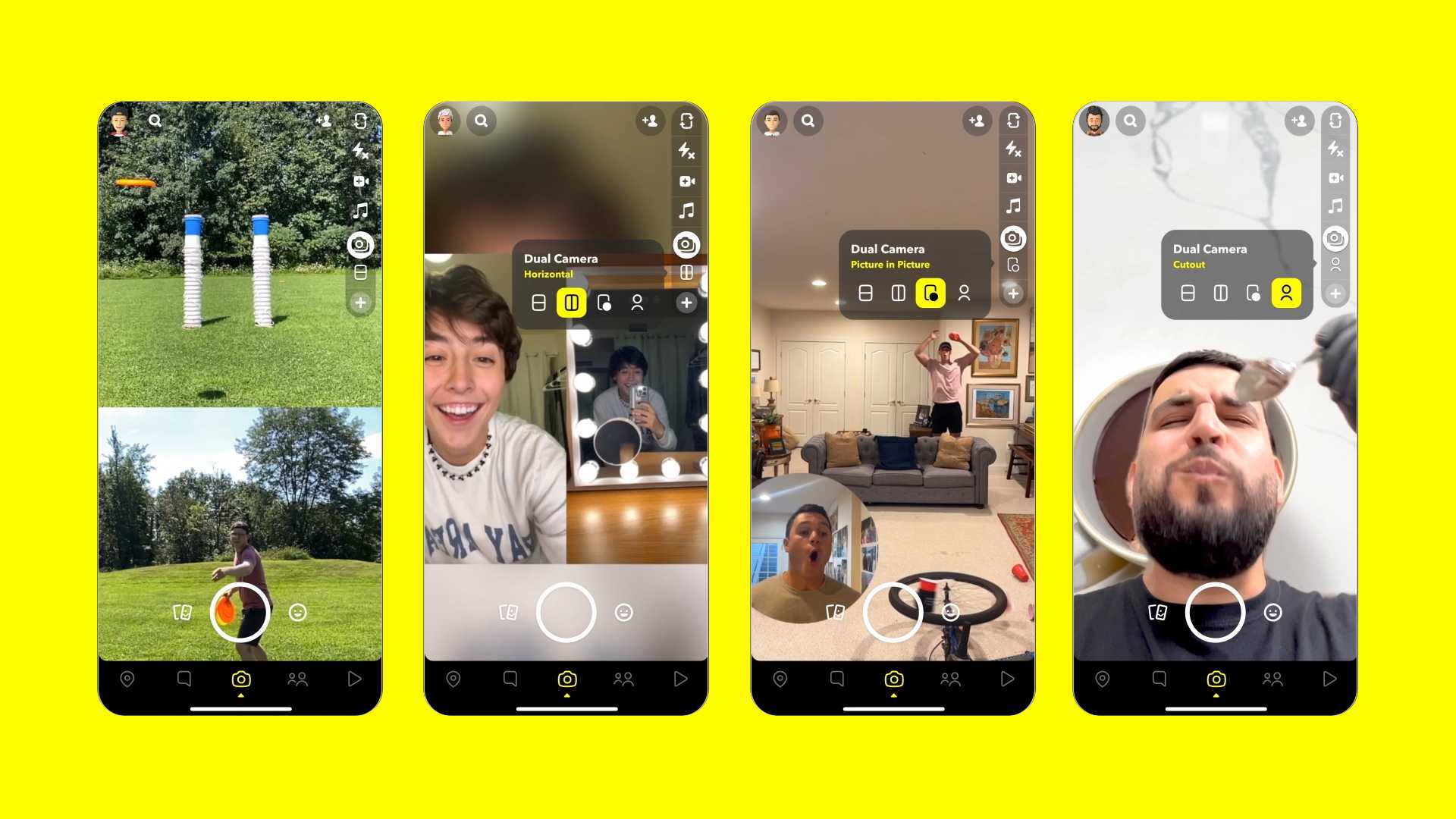
Image Credits: Snapchat
Remember when every social app was copying Snapchat’s Stories — Instagram successfully so? More recently, that sort of copy-and-paste development cycle has been focused on shoehorning a TikTok-like vertical video feed into every other social app, including Instagram and Facebook (Reels), YouTube (Shorts), Snapchat (Spotlight) and others — even Twitter gave it a shot for a time.
But now, the top social apps have set their sights on BeReal, the scrappy social app for unfiltered sharing that’s been sitting just a bit too long at the top of the App Store to keep calling it a “trend.” That has the major social platforms worried about the impact the newcomer is having on their respective user bases. In particular, BeReal seems to be succeeding in appealing to a younger, Gen Z audience in search of a more authentic social networking experience. It allows them to connect with their friends without all the embellishments that, for years, have been the hallmarks of social apps — filters, AR and advanced editing tools resulting in a curated, idealized feed. Instead, BeReal users are in search of imperfection — yet another nail in the coffin for the old “Instagram aesthetic” that’s since been replaced by intentionally poorly shot photos and lo-fi selfies.
Last week, we saw Instagram building out a new feature that’s clearly designed to be a BeReal clone, as it would send Instagram users a notification after which they’d have two minutes to capture and share an “IG Candid” photo to their Story. This is essentially the same mechanic BeReal uses today. Before that, it built a Dual camera feature that lets users shoot from both cameras at once. But that one missed the key component to BeReal’s draw: connecting with friends.
Now Snapchat is jumping on the BeReal bandwagon, with the launch of its own Dual Camera feature. Similar to BeReal, the new mode also lets users capture photos and videos from both their front and back cameras at the same time. But in its case, the app allows users to customize where and how their selfie photo appears — either picture-in-picture, in a horizontal or vertical side-by-side layout or in a unique “image cutout” mode. This latter option cuts out your selfie from the background, then overlays it on top of the footage from the back camera. This differentiates Snap’s feature from BeReal as it could inspire a different type of image-sharing experience to emerge.
It’s also the latest example of how advances in machine learning technologies have been allowing technology companies to do more with users’ photos. Apple, for instance, is introducing an image cutout feature in iOS 16 that lets you cut and paste the subject of a photo into other apps — like texting a picture of your dog’s image cutout in iMessage. This technology is also powering other areas involving photos across iOS — like the “copy subject” feature in mobile Safari or “remove background” in Files, for example.
Elsewhere, Pinterest’s buzzy new app Shuffles is also using image cutouts to allow users to grab images from their Pins for use in collages.
But whether or not an image cutout feature will prove a draw for Snapchat users is still unknown. After all, the dual camera photo-taking tech itself is not driving demand for BeReal — it’s the social connections it enables.
California advances an age-appropriate design code bill for apps
Lawmakers in California have passed a bill, the California Age-Appropriate Design Code Act, that would require apps and websites to increase protections for children, in the absence of any sort of federal standards. The legislation supports the implementation of a range of design changes and features across sites and apps. For instance, companies would have to turn on the highest privacy settings for minors by default — something apps like Instagram have begun doing for minor users (at least new ones), in anticipation of such legislation.
It would also restrict companies from collecting users’ precise locations — a privacy protection that, coincidentally, just went viral on TikTok, as users warned each other how to disable precise location for Instagram’s app in their phone’s Settings. This prompted Instagram head Adam Mosseri to refute the claims users were making, noting that the app was not actually tracking users or sharing their location with others.
Additionally, the bill calls for protections around data collection, prohibiting companies from collecting any data beyond what’s absolutely necessary or using the data collection in a way that would negatively impact the physical or mental health of minors. Apps and sites would also have to have the strongest privacy protections in place, disabling features that personalize the experience based on prior behavior or browsing history, which could affect numerous apps using recommendation algorithms, like TikTok. And it could restrict apps in other ways, like limiting messaging with strangers, and disallowing techniques designed to addict kids into spending hours with the service, among other things.
While such guidelines sound good on paper, the broad and vague language used in the bill could create complications in implementing some of the changes, critics have argued. In addition, privacy advocates pointed out that this could increase the use of age-verification tech, which often requires users to submit personal data in order to use a service.
If signed into law by Governor Gavin Newsom, the bill could become law by 2024.
Weekly News
Platforms: Apple
- Ahead of next week’s event, Apple released iOS 16, beta 8 to developers with additional bug fixes and performance improvements.
- It also rolled out Xcode Cloud subscriptions to developers using Xcode 13.4.1 or later and are members of the Apple Developer Program. The subscription offers 25 compute hours per month for free (until the end of 2023 when it will become $15/mo). Pricing kicks in starting at $49.99/mo for 100 hours and goes up to 1,000 compute hours at $400/mo. Account holders can start, upgrade or downgrade a subscription at any time, Apple says.
- An app developer’s lawsuit over App Store rejections, scams and fraud has ended in a settlement agreement after court filings show a request to dismiss the suit earlier this summer. The plaintiff, app developer and former Pinterest engineer Kosta Eleftheriou, made a name for himself in recent months calling out some of the worst App Store scams. This later culminated in a lawsuit of his own against Apple, filed in California’s Superior Court in Santa Clara County in March 2021, where he alleged his own app had been unfairly rejected from the App Store and then later targeted by scammers, leading to lost revenues. Terms of the settlement were not disclosed.
Platforms: Google
- Google blocked Trump’s social media app, Truth Social, from launching on the Play Store over its content moderation issues. Specifically, Google found the app contained physical threats and incitements to violence, which are banned by its policy. But the app remains live on iOS despite hosting some of the same dangerous content in violation of Apple’s rules. Meanwhile, Google has now reinstated the Parler app to the Play Store after initially removing it over similar content moderation issues following the January 6 Capitol attack.
- Google rolled out third-party in-app billing in the Play Store to additional markets, including India, Australia, Indonesia, Japan and the European Economic Area, making the option available to end users. Interested non-gaming developers can apply for the program and, if they qualify, will be able to use third-party payment systems in their apps. The company announced the program earlier this year. It notes that “reasonable service fees” will still apply to those who make the switch, but didn’t disclose the percentages involved.
E-commerce
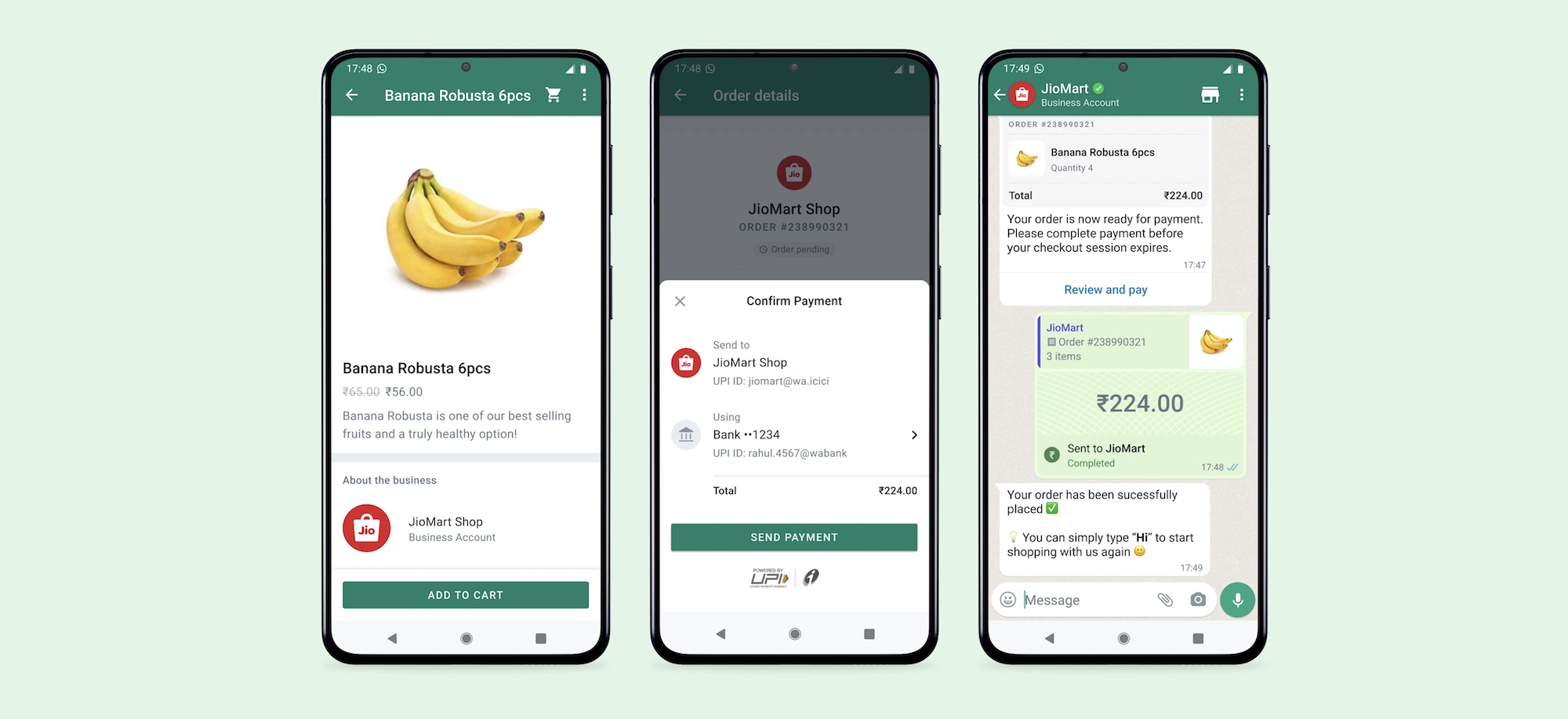
Image Credits: WhatsApp
- Meta partnered with India’s Reliance Retail and Jio Platforms to bring grocery shopping to WhatsApp. The launch will allow customers in India to browse JioMart’s grocery catalog on WhatsApp, then add items to a cart and make the payments via local payments rail UPI without leaving the messaging app.
- Block’s Cash App will now allow users to make payments on e-commerce sites outside the Square network, including with new partners American Eagle, Aerie, Tommy Hilfiger, Finish Line and JD Sports. Other merchants will join in the following months, like Romwe, Savage x Fenty, SHEIN, thredUP and Wish.
Social
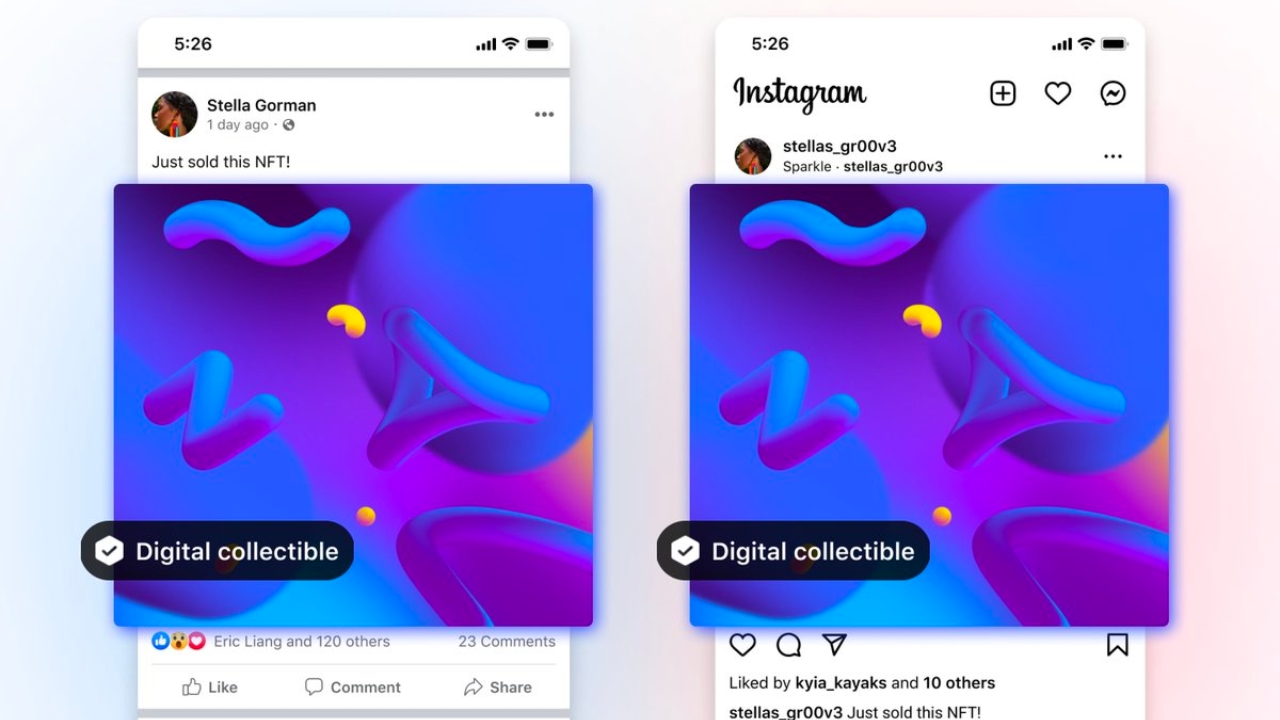
Image Credits: Meta
- Facebook and Instagram now let users post NFTs to their profiles by connecting their wallets, like Rainbow, MetaMask, Trust Wallet, Coinbase Wallet and Dapper Wallet. NFTs minted on the Ethereum, Polygon and Flow blockchains are supported.
- Facebook said it’s shutting down its Nextdoor clone called Neighborhoods next month after realizing that Facebook Groups was actually just fine for this purpose. It also recently shut down live shopping and its standalone gaming app.
- Instagram began testing new features that will help users better control what they see on the app. This includes the option to mark multiple posts on the Explore page as “Not Interested,” and another option that will let you tell Instagram you want to stop seeing posts with content you’re no longer interested in.
- Twitter launched its “close friends” feature, Twitter Circle, to global users. The feature allows users to add up to 150 people to their Twitter Circle in order to make some tweets available only to those they know and trust instead of to the wider public.
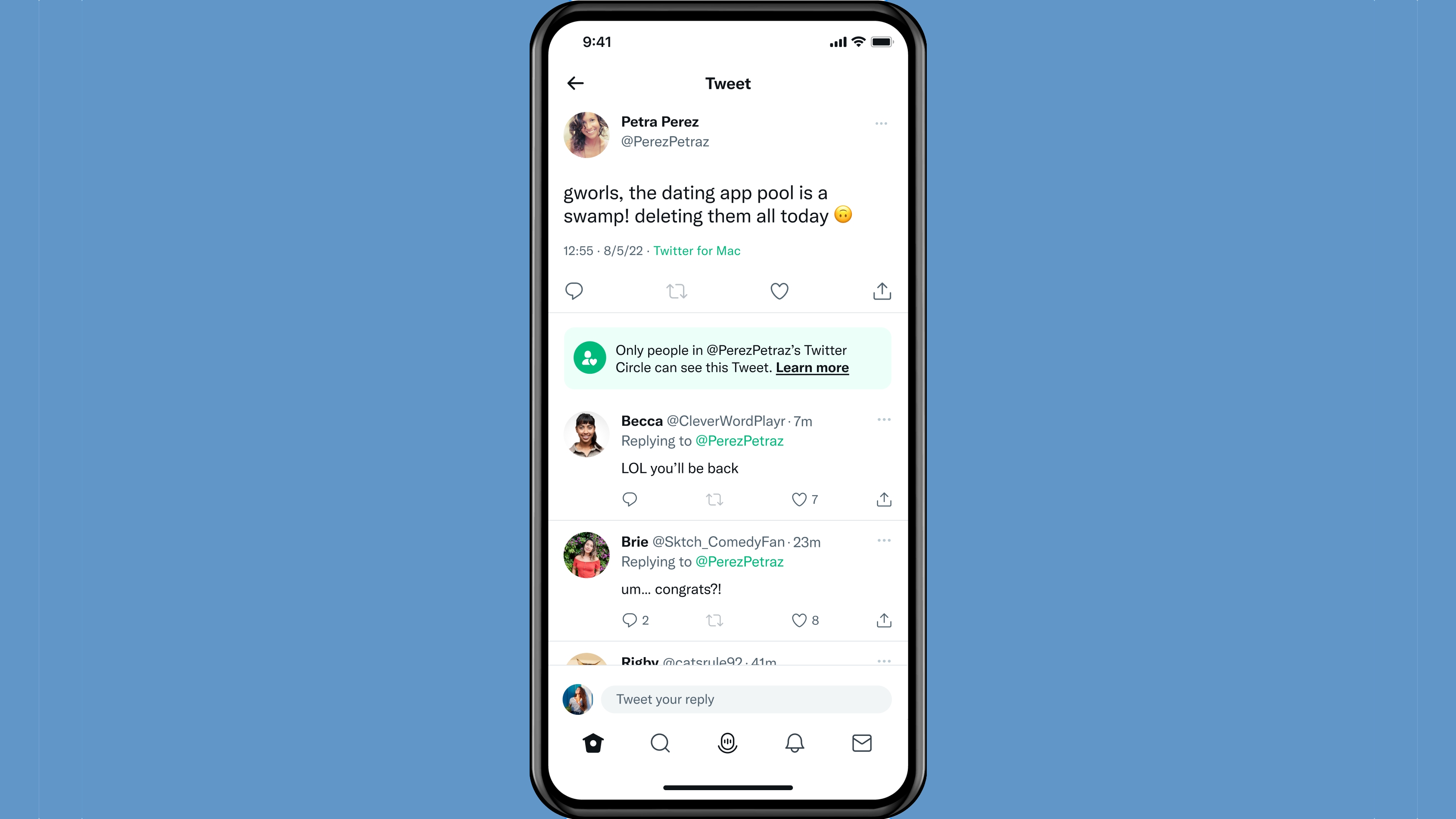
Image Credits: Twitter
- Twitter was reportedly working on an OnlyFans competitor, The Verge reported, but ended those efforts due to issues with CSAM on the platform.
- TikTok laid off employees from its U.S. ad department, amid a restructuring, The Information reported. The head of the ad sales team, former Meta executive Blake Chandlee, had forewarned about layoffs earlier this month.
- Snap also confirmed it would lay off around 20% of its 6,400-plus staff, after The Verge reported on its plans. The company also said it would cancel its original shows and in-app games, and would shut down its Zenly and Voisey apps. The Zenly shutdown is most surprising, given the app is still fairly popular with 35 million MAUs.
- Last summer’s hit social app Poparazzi’s parent company, TTYL, is prepping a new social app that adds the ability for users to post not only photos but also videos, and answers to questions and prompts to their friends’ profiles. The app, called Made With Friends, is due out in October.

Image Credits: Made With Friends
Messaging
- Google brought back the Duo icon with an update to its Google Meet Android app after recently consolidating the Meet and Duo apps, making “Meet” the surviving brand. The company said this would help people who were searching for “Duo” to find and launch the newly merged application.
- An Indian court ordered Telegram to disclose details of channels violating copyright in a lawsuit filed by a teacher. The teacher shared a list of channels circulating her lectures and books on competitive exams, which were being sold on these channels at discounted prices, she said.
- Researchers at the University of Washington made an underwater communication app, AquaApp, that uses sonic signals to pass messages. The system uses the phone’s speaker to create high-frequency audio signals to communicate.
Streaming & Entertainment
- Alongside its announcement of NBC’s Dateline as its latest podcast subscription, Apple shared that the number of Apple Podcast subscribers had grown by 300%+ since June 2021 and 25%+ of the top 100 shows in its Top Shows chart now offer a subscription.
- Sony Music sued Triller over copyright infringement after missing payments, its lawsuit alleges.
- Netflix snatched up two Snap executives to lead its new ad-supported business: Chief Business Officer Jeremi Gorman and VP of Sales for the Americas Peter Naylor, according to The Verge.
Dating
- Video dating app Filter Off described to TechCrunch how it used GPT-3 to create a number of chatbots combined with a script to create human-like faces to trick scammers into interacting with fake dating app profiles. These profiles weren’t seen by normal app users, only by those the algorithm identified as scammers. This ended up with scammers trying to scam each other or scam other bots. Read the full story here.
Gaming
- Facebook is shutting down its standalone Facebook Gaming app on iOS and Android on October 28, 2022 and will transfer games, content and groups over to the main Facebook app. The move comes as the company prioritizes its investments around discovery and recommendations in the main Facebook feed, leading to other closures like live shopping and its specialized neighborhood groups product.
- Epic Games defeated another copyright infringement lawsuit over its Fortnite dances. This one had claimed Fortnite ripped off a choreographer’s routine for the “It’s Complicated” emote in the game. A judge ruled the two dances didn’t share enough creative elements for the emote to be considered infringement.
- Meta renamed its Oculus Mobile app to “Meta Quest” as its continues it transition away from the Oculus branding to take on the Meta name.
Health & Fitness
- Streaming music service Deezer entered the wellness market with the launch of an app called Zen featuring guided yoga, meditation and other inspiration that can be recommended based on mood or goals. The app will roll out more broadly in 2023, offering the company the opportunity to cross-sell content, it said.
Utilities
- Keyboard tech licensing startup Fleksy expanded its SDK to indie devs and app makers who want to add more text input features — like text input autocorrection, prediction and swipe — to their apps.
- Truecaller released an update to its iOS app featuring better spam detection, faster performance, quick onboarding and a smaller app size. The new app also addresses user concerns over call detection and spam identification that had previously worked better on Android.
Travel & Transportation
- Uber updated its app with new safety features, including a new way to text 911 and others in partnership with ADT. Now, tapping the shield-shaped icon will bring up four options: contact 911, contact an ADT safety agent, share trip status or report a safety issue to the company.
Government & Policy
- The U.S. Department of Justice is in the early stages of drafting an antitrust lawsuit against Apple, according to sources cited by Politico. While the report suggested a potential suit could arrive by the end of the year, it also stressed that a final decision about if or when to sue Apple had not yet been made.
- The U.S. Federal Trade Commission (FTC) filed a lawsuit against data broker Kochava Inc. for selling geolocation data from “hundreds of millions of mobile devices,” it says, which could be used to trace the movements of individuals, including those to and from sensitive locations.
Security & Privacy
- Microsoft revealed how a high-severity vulnerability impacted TikTok users on Android. Though now patched, the vulnerability could have allowed attackers to take over user accounts that clicked on a malicious link.
Funding and M&A
 Sony acquired mobile game developer Savage Game Studios for an undisclosed sum. The company will join Sony’s newly created and independently operating PlayStation Studios Mobile Division, which will focus on creating games based on new and existing PlayStation IP.
Sony acquired mobile game developer Savage Game Studios for an undisclosed sum. The company will join Sony’s newly created and independently operating PlayStation Studios Mobile Division, which will focus on creating games based on new and existing PlayStation IP.
 OneSignal, a startup that helps businesses automate SMS, email and in-app campaigns, raised $50 million in Series C funding, led by BAM Elevate. The company has raised $80 million to date and counts around 6,000 paying customers.
OneSignal, a startup that helps businesses automate SMS, email and in-app campaigns, raised $50 million in Series C funding, led by BAM Elevate. The company has raised $80 million to date and counts around 6,000 paying customers.
 Investing app Landa, which lets users make fractional investments in rental properties, emerged from stealth with an $8 million seed and $25 million Series A, co-led by NFX, 83North and Viola. To date, users have invested in around 400 properties in the app across NYC and Atlanta. It’s soon launching in Charlotte, Birmingham, Tampa, Orlando and Jacksonville, Florida.
Investing app Landa, which lets users make fractional investments in rental properties, emerged from stealth with an $8 million seed and $25 million Series A, co-led by NFX, 83North and Viola. To date, users have invested in around 400 properties in the app across NYC and Atlanta. It’s soon launching in Charlotte, Birmingham, Tampa, Orlando and Jacksonville, Florida.
 PsycApps, a gamified mental health app for teens and adults, raised $1.7 in seed funding from U.S.-based Morningside Ventures. The startup has been through clinical trials, allowing it to secure contracts with schools in the U.K., including Regional College and Paragon Skills.
PsycApps, a gamified mental health app for teens and adults, raised $1.7 in seed funding from U.S.-based Morningside Ventures. The startup has been through clinical trials, allowing it to secure contracts with schools in the U.K., including Regional College and Paragon Skills.
 Reddit acquired audience contextualization company Spiketrap to boost its ads business for an undisclosed sum. Reddit says Spiketrap’s AI-powered contextual analysis and tools will help Reddit to improve in areas like ad quality scoring and will boost prediction models for powering auto-bidding.
Reddit acquired audience contextualization company Spiketrap to boost its ads business for an undisclosed sum. Reddit says Spiketrap’s AI-powered contextual analysis and tools will help Reddit to improve in areas like ad quality scoring and will boost prediction models for powering auto-bidding.
 Grocery delivery app Instacart is acquiring Eversight, an AI-powered pricing and promotions platform for Consumer Packaged Goods (CPG) brands and retailers, for an undisclosed sum.
Grocery delivery app Instacart is acquiring Eversight, an AI-powered pricing and promotions platform for Consumer Packaged Goods (CPG) brands and retailers, for an undisclosed sum.
 Triller reportedly raised $200 million in debt and equity per a report by The Wrap, and is targeting a $3 billion valuation in its expected IPO this year.
Triller reportedly raised $200 million in debt and equity per a report by The Wrap, and is targeting a $3 billion valuation in its expected IPO this year.
Downloads
Robin Games’ PLAYHOUSE

Image Credits: Robin Games
Women-led mobile gaming startup Robin Games raised funding around the idea of carving out a new niche in the market of “lifestyle gaming” by creating a fantasy gaming experience that’s more sophisticated and stylish — something more in line with the sort of content you’d typically find in a lifestyle magazine or Instagram influencer’s profile. This week, the startup released its first title to tackle this concept with the launch of a mobile game, PLAYHOUSE, which combines both gameplay and shopping in one experience.
Available on iOS and Android, PLAYHOUSE is a DIY design game that allows players to drag-and-drop furniture and décor into spaces to create original looks for rooms using elements like wall art, sofas, chairs, tables, plants and more. Unlike some competing design games, the pieces can be moved, rotated, resized or layered to create a unique look. But what makes this experience even more interesting is that users can shop the items in the game by clicking through to the retailer’s website. At launch, it’s partnering with over 100 brands like Arhaus, Article, 1stDibs, Chairish, One Kings Lane, ABC Carpet & Home, Jenni Kayne, Society6, Bloomscape, Room & Board and Lulu & Georgia, and others.
The app monetizes as a free-to-play title with in-app purchases, however, not affiliate commissions. (Read the full review on TechCrunch.)
Duolingo’s new Math app (waitlist)
Language learning app maker Duolingo has launched its latest creation, Duolingo Math, announced during its Duocon conference — after first being teased at the event the year prior. Similar to how Duolingo turns language learning into mini-games, the new app will teach third-grade math to users in a snack-sized experience aimed at making learning fun and accessible. The company says the new app will initially be available to iPhone and iPad users who sign up for the waitlist.
Based in Japan, biotech startup Dioseve’s ambitious goal is to grow human oocytes, or eggs, from other tissue. Its aim is to help people struggling with infertility, and it recently raised $3 million led by ANRI, with participation from Coral Capital.
Dioseve’s mission might sound like it comes out of science fiction, but it’s based on a scientific technique called induced pluripotent cells stem (iPS) cells, which was first developed in 2006.
The startup’s scientific advisor, Dr. Nobuhiko Hamazaki, a research specialist at the University of Washington, created Dioseve’s technology, called DIOLs (directly induced oocyte-like cells), which can turn iPS cells into oocytes en masse. DIOLs is currently in trials and has been published in scientific journal Nature.
The new funding will enable Dioseve to hire more people and accelerate its research and development. It aims to establish proof of concept by having mice give birth with DIOLs produced oocytes, and recently established a new lab in Tokyo and hired an iPS specialist.
As Dr. Hamazaki explains, induced pluripotent stem cells can be used to grow all of the cells in the body. For example, other researchers are finding ways to use iPS to grow organs outside of the body, induce beta cells in the pancreas in an attempt to cure diabetes and generate neural stem cells to cure spinal injuries. iPS cells can be made from tissue like muscle or blood cells.
DIOLs first makes primordial germ cells, the source of sperm and oocytes. It differentiates between them to find oogonia, or the precursor of oocytes and then introduces genes into the iPS cells. This means that people who are dealing with infertility can potentially use DIOLs to have offspring with their own genetic material.
Dr. Hamazaki said that in the case of mice, it usually takes 30 days to get oocytes, and that with human oocytes, it can take up to six months.
Dioseve’s CEO is Kazuma Kishida, who became interested in biotechnology when he was diagnosed with hepatitis C as a teenager. At that time, the available treatment had heavy side effects and a low response rate, so his doctor told him to wait a few years, since a new drug was being developed in the United States. After three years, Kishida got the treatment, curing his hepatitis C. “That drug really changed and contributed to the world,” he said. “I wanted to do something that could change the world like the new drug did.”
Kishida said Dioseve has been giving a lot of thought to the safety and ethics of DIOLs by having conversations with potential patients and science and medical ethics specialists. Right now, issues it is monitoring include the inheritance effect of the technology—can it not only produce healthy babies, but also avoid health issues in subsequent generations?
“We are really serious about ethics. We need to be very careful because this technology can be applied to the process of making a child,” said Dr. Hamazaki, adding “we need to have a deep conversation with society to get a consensus if this is applicable, and the range we can apply this technology.”
Dioseve isn’t the only biotech startup researching ways to grow human oocytes. Others include Ivy Natal and Conception, both based in San Francisco, which are also developing ways to grow eggs from other cells. Dioseve says its competitive edge is its research progress and practicality.
Snapchat today is rolling out its first set of parental controls, after announcing last October it was developing tools that would allow parents to gain better visibility into how their teens used the social networking app. The update follows the launches of similar parental control features across other apps favored by teens, including Instagram, TikTok and YouTube.
To use the new feature, known as Family Center, parents or guardians will need to install the Snapchat app on their own device in order to link their account to their teens through an opt-in invite process.
Once configured, parents will be able to see which accounts the teen is having conversations with on the app over the past seven days, without being able to view the content of those messages. They’ll also be able to view the teen’s friend list and report potential abuse to Snap’s Trust & Safety team for review. These are essentially the same features TechCrunch reported earlier this year were in development.
Parents can access the new controls either from the app’s Profile Settings or by searching for “family center” or related terms from the app’s Search feature.
Snap notes the feature is only available to parents and teens aged 13 through 18 as the app is not meant to be used by younger users. The launch comes on the heels of increased pressure on social networks to better protect their minor users from harm both in the U.S. and abroad. This has led big tech companies to introduce parental controls and other safety features to comply with E.U. laws and expected U.S. regulations.
Other social networks have introduced more expansive parental controls compared with what’s available at launch from Snapchat’s Family Center. For example, TikTok allows parents to set screen time controls, enable a more “restricted mode” for younger users, turn off search, set accounts to private, restrict messaging as well as who can view the teen’s likes and who can comment on their posts, among other things. Instagram also includes support for time limits set by parents alongside its parental controls.
Snap, however, points out that it doesn’t require as many parental controls because of how its app was designed in the first place.
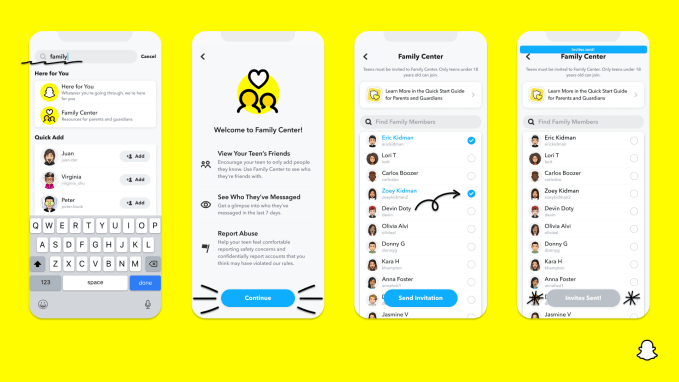
Image Credits: Snap
By default, teens have to be mutual friends to begin communicating — so there’s a reduced risk of them receiving unwanted messages from potential predators. Friend lists are private and teens aren’t allowed to have public profiles. In addition, teenage users only show up as “Suggested Friends” or in search results when they have mutual friends in common with the user on the app, which also limits their exposure.
That said, parents’ concern over Snapchat isn’t limited to fears of unwanted contact between teens and potentially dangerous adults.
At its core, Snapchat’s disappearing messages feature makes it easier for teens to engage in bullying, abuse and other inappropriate behavior, like sexting. As a result, Snap has been the subject of multiple lawsuits from grieving parents whose teens committed suicide. They claim that Snap’s platform helped facilitate online bullying, which has since led the company to revamp its policies and limit access to its developer tools. It also cut off friend-finding apps which had encouraged users to share their personal information with strangers — a common avenue for child predators to reach younger, vulnerable Snapchat users.
Sexting has also been an issue of multiple lawsuits. Most recently, a teenage girl initiated a class-action lawsuit against Snapchat which alleges its designers have done nothing to protect against the sexual exploitation of girls using its service.
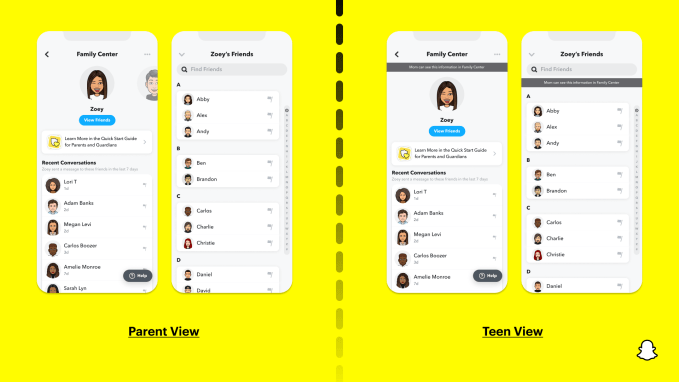
Image Credits: Snap
With Snapchat’s new Family Center, the company is giving parents some insight into teens’ use of the app — but not enough to fully prevent abuse or exploitation, as it favors maintaining the teen’s privacy.
For parents, the ability to view a teen’s friends’ list doesn’t necessarily help them understand if those contacts are safe. And parents don’t always know the names of all their teens’ classmates and acquaintances, only those of their closer friends. Snap also doesn’t allow parents to block their teens from sending photos to friends privately, nor has it implemented a feature similar to Apple’s iMessage technology which automatically intervenes to warn parents when sexually explicit images are being sent in chats. (Though it does now tap into CSAI Matching technology to remove known abuse material.)
The Family Center also offers no controls over if and how their teen can engage with the app’s Spotlight feature, a TikTok clone of short videos. Nor can parents control whether or not their teen’s live location can be shared on the in-app Snap Map. And parents can’t control who their teens can add as friends.
The company’s Discover section is ignored by the parental controls, as well.
In a Congressional hearing last year, Snap had been asked to defend why some content in its Discover section was clearly aimed at adults — like invites to sexualized video games, articles about going to bars or those about porn, and other items that seemed out of sync with the app’s age rating of 13+. The new Family Center offers no control over this part of the app, which includes a sizable amount of clickbait content.
We’ve found this section consistently features intentionally shocking photos and medical images — similar to the low-value clickbait articles and ads you’ll see smattered across the web.
At the time of writing, a quick scroll through Discover uncovered various articles designed to frighten or alarm — at least three articles featured photos of giant spiders. Another was about a parent who murdered her children. One story focused on Japan’s suicide forest and another was about people who died at theme parks. There was also a story of a teacher caught “cheating with” (its words) a 12-year-old student — a truly disgusting way to title a story about child sexual abuse. And there were multiple photos of rare medical conditions that should probably be left to a doctor’s viewing, not shown to younger teens.
Snap says a future update will introduce “content controls” for parents and the ability for teens to notify their parents when they report an account or a piece of content to Snap’s safety team.
“While we closely moderate and curate both our content and entertainment platforms, and don’t allow unvetted content to reach a large audience on Snapchat, we know each family has different views on what content is appropriate for their teens and want to give them the option to make those personal decisions,” a Snap spokesperson said of the upcoming parental control features.
The company added it would continue to add other controls after gaining more feedback from parents and teens.
Although the mobile app boom driven by pandemic lockdowns has long since passed, consumers’ mobile usage is still growing. According to new data released today by app intelligence firm data.ai (previously App Annie), consumers in over a dozen worldwide markets are now spending four to five hours per day in apps.
While the daily time spent in apps varies by country, there are now 13 markets where users are spending more than 4 hours per day using apps. These include Indonesia, Singapore, Brazil, Mexico, Australia, India, Japan, South Korea, Canada, Russia, Turkey, the U.S. and the U.K. And, in three of those markets — Indonesia, Singapore, Brazil — mobile users are spending more than 5 hours per day in apps.
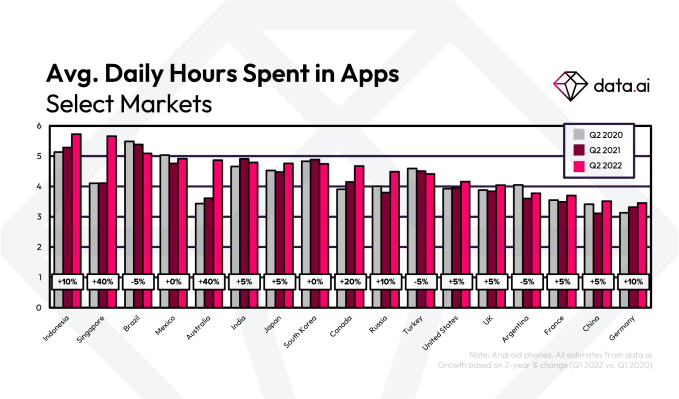
Image Credits: data.ai
While the growth in app usage has slowed a bit from the second quarter in 2020, it’s worth noting that two years ago was the height of Covid lockdowns which drove app usage to spike across all categories as users worked, shopped, banked, gamed, as well as studied and attended meetings, school and events from home.
Still, the data suggests the pandemic may have led to longer-lasting impacts on app usage. It seems mobile consumers who adopted new apps and behaviors during the pandemic may have kept at it, despite the so-called “return to normal” in 2022.
Illustrating this point, some markets saw significant gains in app usage over the past two years. In the second quarter of 2020, Singapore users were spending 4.1 hours in apps. Now that’s grown to 5.7 hours, the report says. In Australia, users went from 3.6 hours to 4.9 hours from Q2 2020 to Q2 2022. Both represent a 40% rise in time spent.
Other markets saw slower growth including Indonesia (+10%), India (+5%), Japan (+5%), Canada (+20%), Russia (+10%), the U.S. (+5%), U.K. (+5%), China (+5%), and Germany (+10%). A few markets saw no growth or a bit of a slowdown, such as Mexico (0%), Turkey and Argentina (both at -5%) — but again, comparisons to peak Covid timeframes indicate that trends are simply normalizing to pre-Covid levels.
The firm’s report also included the top ranked apps and games for the second quarter, which saw Instagram in the top spot worldwide by downloads and TikTok at No. 1 by consumer spend, in terms of non-gaming apps. Facebook was still No. 1 by monthly active users, ahead of WhatsApp, Instagram, Messenger, TikTok, Telegram, Amazon, Twitter, Spotify and Netflix.
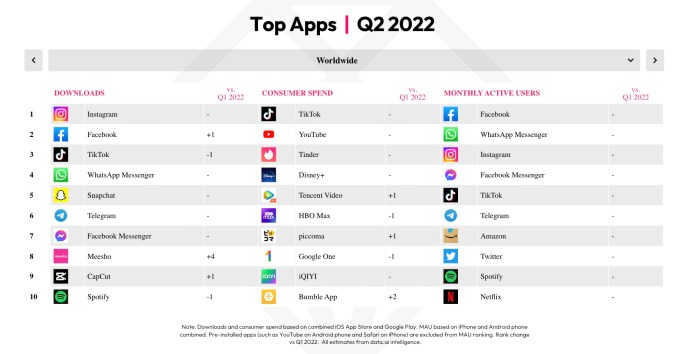
Image Credits: data.ai
Notable movers in the quarter included Indian e-commerce app Meesho, which jumped to No. 8 by downloads; the multiplayer party knockout game Stumble Guys, which rose 23 places; and hyper casual game Fill The Fridge, which moved up 84 places. Meanwhile, Pokemon Go saw a boost in usage thanks to the new season that launched on June 1 ahead of the Pokemon Go Fest in early June.
A major shift in the U.S. app economy has just taken place. In the second quarter of this year, U.S. consumer spending in non-game mobile apps surpassed spending in mobile games for the first time in May 2022 and the trend continued in June. This drove the total revenue generated by non-game apps higher for the quarter, reaching about $3.4 billion on the U.S. App Store, compared with $3.3 billion spent on mobile games.
After the shift in May, 50.3% of the spending was coming from non-game apps by June 2022, according to new findings in a report from app intelligence firm Sensor Tower. By comparison, games had accounted for more than two-thirds of total spending on the U.S. App Store just five years ago.
The trend was limited to the U.S. App Store and was not seen on Google Play, however. In Q2, games accounted for $2.3 billion in consumer spending on Google Play in the U.S., while non-game apps accounted for about $1 billion.
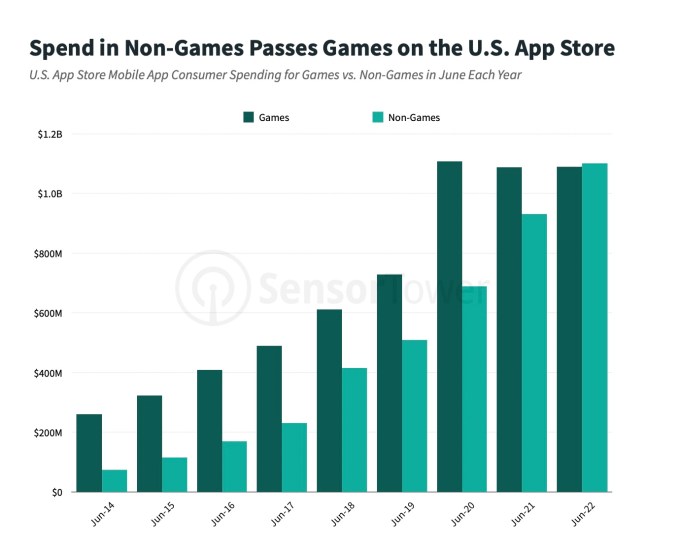
Image Credits: Sensor Tower
This shift in the U.S. app market is the most significant finding in the new report and demonstrates how successfully Apple has managed to create a subscription economy that allows a broader range of apps to generate sizable revenues.
The new data also supports this, as it shows it’s not only the biggest players that are benefiting from subscription revenue growth. In Q2 2022, 400 apps generated more than $1 million in consumer spending on the U.S. App Store, which is eight times the total from the same quarter in 2016. In addition, 61 U.S. App Store non-game apps generated at least $10 million in U.S. consumer spending in Q2 2022 — that’s more than the number of non-game apps that had generated $1 million+ in revenue in Q2 2016.
A handful of non-game apps also topped $50 million in U.S. consumer spending in the quarter, including YouTube, HBO Max, TikTok, Tinder, Disney+, Hulu and Bumble.
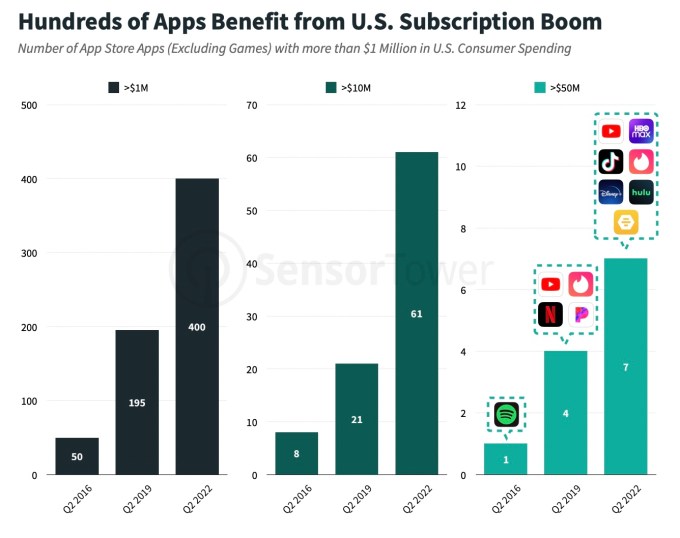
Image Credits: Sensor Tower
Subscriptions are the major revenue growth driver here, as non-game apps grew at nearly twice the rate — at a 40% compound annual growth rate — since June 2014 compared with less than 20% for games, the report found.
The trend is a significant reversal of what mobile app spending looked like just a few years ago.
In 2019 and early 2020, for instance, mobile game spending growth was consistently higher than non-game spending. Game spending then surged again at the start of the Covid-19 pandemic. But by late 2020, non-game growth had caught up and the gap widened in 2021.
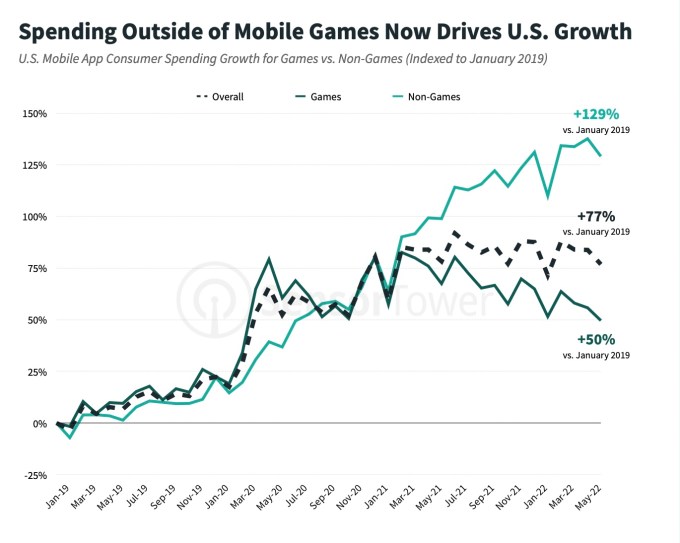
Image Credits: Sensor Tower
While non-games are enjoying their new dominance, it’s not all great news for the app economy in this most recent quarter. The report also found that U.S. app spending overall declined for the first time in Q2, following the wind-down from the spike generated by the pandemic.
At the start of the pandemic (around April 2020), year-over-year growth in consumer spending had jumped from around 20-30% in 2019 to 35-55% over the next 12 months. But in May 2022, U.S spending declined for the first time as consumers began to shift their dollars back to other non-mobile activities like restaurant dining and travel.
Despite this decline from the pandemic highs, consumer spending in Q2 2022 was still up 71% over Q2 2019.
In other key findings from the quarter, summer travel drove travel apps to record high downloads in the U.S. and U.K., and airline app downloads in these markets were up 30%+ compared with Q2 2019, before the pandemic.
Meanwhile, the top five ticketing apps saw 10 million downloads, up 70%+ from Q2 2019 as consumers returned to concerts, sports games, and other events.
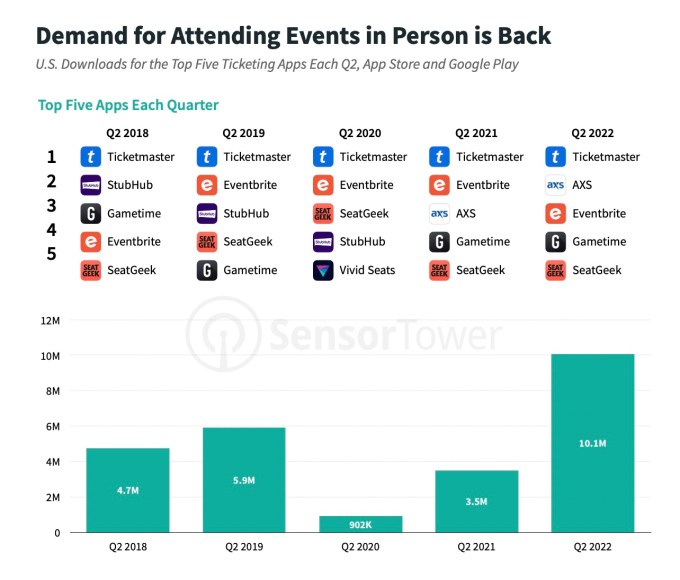
Image Credits: Sensor Tower
Worldwide app downloads slowed also slowed in the quarter, as installs totaled 35 billion in Q2, down 2.5% year-over-year. App Store downloads fell 1.3% to 7.8 billion and Google Play installs dropped 3% to 27.2 billion.
The most downloaded non-game app worldwide was TikTok, which has held the top position 8 times out of the past 10 quarters. It was followed by Instagram, Facebook, WhatsApp, and Snapchat. TikTok (including Douyin in China on iOS) had 187 million downloads in the quarter.
The top mobile game globally was Subway Surfers, with over 80 million downloads — its highest total since 2014, and following the game’s maker Sybo acquisition by gaming giant Miniclip in June 2022. The number two title was Garena Free Fire with 70 million installs for the third quarter in a row.
YuLife originally made a name for itself in its home market of the U.K. for its new approach to the provisioning of life insurance: yes, sell a policy that provides financial security to your people in the event of your death; but do so with a focus on improving the policyholder’s current life with wellness opportunities, and encourage use of that with gamification — a model that not only is aimed at benefitting the policyholders more, but increases engagement on the platform and provides a complementary revenue for YuLife, which offers deals on the wellness services.
Its idea took off — it is now used by more than 500 businesses, including Co-op, Del Monte, Jaguar Land Rover, Santander and CapitalOne, which in turn provide plans to their employees, one of three of whom engage on the app daily. On the heels of that, now the company is announcing that it has raised $120 million to expand the concept. Today, YuLife covers group life insurance, critical illness protection and income protection, but it is now rapidly expanding to new categories like dental and health, as well as financial services (pensions being one example of a category that has a strong affinity with life insurance), as well as to new markets like the U.S.
The funding, a Series C, is bringing a new strategic investor on board, Japan’s Dai-ichi Life Insurance Company, which is leading the round, along with participation from previous investors Creandum, LocalGlobe, Target Global, Latitude, Anthemis, OurCrowd, Notion, MMC and Eurazeo.
CEO and co-founder Sammy Rubin tells us that this latest fundraise values the company at $800 million. For some context on that figure, when YuLife more recently raised money before this — a Series B of $70 million in 2021 — it was valued at $346 million.
That is a decent jump considering the current climate. Many tech companies are finding it hard to raise rounds, and when they are doing so valuations are definitely getting buttoned down (and in a number of cases seeing down-rounds). And insuretech specifically is definitely not being spared: on the heels of a boom during the peak of the Covid-19 pandemic, insurance technology funding in Q1 2022 was 50% lower than a year ago, and Q2 is shaping up to be even slower, according to research from Dealroom.
Part of the reason for YuLife’s bump is that the company itself has continued to grow through the slowdown.
Rubin tells me that its customers — it sells only directly to organizations in a B2B model, who in turn provide life insurance their employees as part of larger benefits programs — have grown 4X in the last year (not as many as the year before, which was 10X, but still growing), with revenues up five-fold, and coverage now totaling $50 billion, versus $15 billion a year ago. Close to 50% of its customers are new to the platform, he said, and in doing so is expanding the scope of those that are considering it as a worthwhile benefit for their employees.
“These are companies that had never had life insurance before,” Rubin said, noting that they are attracted not just “by the whole life insurance benefit, but the holistic platform around it.”
That holistic platform is an interesting twist on the basic concept of what life insurance can be about.
The app is built by veterans of the gaming industry and is designed around the concept of different natural environments such as forest and mountains, which YuLife collectively terms its “Yuniverse.”
Within each of these environments, users are encouraged to walk, cycle, meditate and do other activities to get around their environments in a healthy way, while at the same time being able to compare their progress against other co-workers. As with a lot of gaming these days, is a degree of personalization in everyone’s experience: one person leaning into one activity over another seems to produce different subsequent scenarios.
Along with this, users are offered discounts on third-party products to further engage with the game within YuLife, which could include a subscription to meditation app Calm, FitBit and Garmin devices, and more. As users make their way through their worlds, they get rewards, in the form of something called YuCoins. The YuCoins can in turn be used to redeem vouchers from the likes of Amazon and Asos.
Group life insurance, Rubin said, is the company’s flagship product and accounts for over 80% of revenues. Its other products — currently critical illness, income protection and dental — account for the other 20%. Its revenues, he added, are attributed to the sale of insurance policies. “Our insurance policies are holistic and include the wellness element,” he said.
Wellness in itself is a massive opportunity — worth some $1.5 trillion in 2021 according to McKinsey estimates — and while you can see a strong affinity between how that might be oriented around a life insurance product, and indeed a health insurance product, it will be interesting to see how YuLife tailors the concept to other kinds of insurance, and to other products such as financial services. Rubin noted that right now one of the perks in the dental product is a free electric toothbrush for each new user (although users still have to pay to replace the heads).
In terms of the other way that YuLife could grow, Rubin added that it has “no plans” to become a D2C product, but to continue selling through companies. This continues to set it apart from the wider wave of insurtechs, which have largely disrupted the incumbent market by improving accessibility to getting insurance in the first place.
AIG, Met Life and Zurich are YuLife’s current underwriters in the U.K. and Rubin said the company is currently negotiating with underwriters and other partners for its U.S. launch. Dai-chi Life does have operations in the U.S. market — among other activities it owns Protective Life — but Rubin said the strategic element of this investment is not aimed at that, but rather a longer-term plan also to expand into Japan.
“Dai-ichi Life is committed to supporting companies that have a proven track record of changing people’s lives for the better, and YuLife does exactly that, by bringing tangible value to financial products to bolster individuals’ wellbeing,” said Toshiaki Sumino, director and managing executive officer at Dai-ichi Life Holdings, Inc., in a statement. “YuLife has immense potential to build on its achievements to date, and we are thrilled to invest and help propel YuLife towards its next steps and scale its global operations. YuLife shares our ethos of harnessing the latest trends in technology to make a genuine difference to the lives of those using financial products.”
Quantum computing has been making quantum leaps of progress in the last several years — going from theoretical concept to multiple testing environments, to help organizations prep for a time when quantum computers, and their unparalleled processing power, become a scaled reality. Now, UK-based Oxford Quantum Circuits is announcing £38 million ($47 million) in funding to fuel the growth of its own contribution to the space — a patented 3D processor architecture it calls Coaxmon, plus quantum-computing-as-a-service that will run on it. OQC says that this Series A is the largest to date for a UK-based quantum computing startup.
“We work at pace, and our systems are being optimized. We’ll continue to scale and reduce error rates,” said Ilana Wisby, OQC’s founding CEO, in an interview. “Our vision is seamless quantum access.”
Lansdowne Partners and The University of Tokyo Edge Capital Partners (UTEC) a deep tech fund out of Japan, are co-leading the round, with British Patient Capital, Oxford Science Enterprises (OSE) and Oxford Investment Consultants (OIC) also participating. OSE and OIC previously led a £2.2 million seed round into the startup, which began life as a spinout from Oxford University and work done there by quantum physicist (and OQC founder) Dr Peter Leek.
The plan will be to use the funding to keep hiring more talent (it’s now at 60 employees), continue improving accessibility to quantum computing for developers interested in working with it, and to continue building out its computing infrastructure, which today is based on an 8-qubit machine. And as you might guess from the investor list, it will also be using some of the funds to expand into Asia Pacific, and specifically Japan, to tap would-be customers there in financial services and beyond.
“Quantum computing promises to be the next frontier of innovation, and OQC, with its state-of-the-art Coaxmon technology, aims to integrate the forefront of modern physics into our everyday lives,” said Lenny Chin, a principal at UTEC, in a statement. “UTEC is honoured to be part of OQC’s mission of making quantum technology accessible to all and will support OQC’s expansion into Asia-Pacific through collaborations with academia including the University of Tokyo, and partnerships with Japan’s leading financial and tech corporations.”
Wisby told me that OQC actually started raising this Series A before the pandemic, back in early 2020; but it opted to shelve that process and go for grants instead to build out the company in its earlier phases.
That got OQC quite far, advancing from a 1-qubit, to a 2-qubit, then a 4-qubit, and now currently an 8-qubit machine.
The startup is also already providing services to a variety of customers who work across either OQC’s private cloud or via Amazon Braket, AWS’s quantum computing platform that also provides developers access to other quantum-as-a-service providers such as Rigetti, IonQ and D-Wave. (OQC notes that its quantum computer, named Lucy, is the first European quantum provider on Braket — a key detail for companies and quantum researchers based out of Europe who need to comply with data protection laws by keeping data and the processing of it local: this gives them a local option.)
Its customers include Cambridge Quantum, which runs its IronBridge cryptographic number generator on OQC’s computer; financial services companies; molecular dynamics researchers; government organizations and large multinationals with in-house R&D teams working on systems capable to be run on quantum machines when they are eventually spun up.
“Eventually” is the operative word here: the real promise of quantum computing is vast computing power, but there has yet to be a quantum computer built that can achieve that at scale without also producing a lot of errors.
But it seems that a lot of the hope these days is not on “if” but “when” that hurdle will be overcome. “We’re well past theory,” Wisby said.
That’s led to a big wave of both large tech players such as IBM, Amazon and Alphabet to get involved, as well as a number of smaller startups, and companies like Rigetti, IonQ and D-Wave that sit between those two poles. While there are some opting to build and sell quantum devices, the economics don’t make sense for most potential use cases, so for now the bigger efforts appear to be around quantum in the cloud: offering it as an infrastructure-free, use-as-you-need-it compute service.
Although Oxford Quantum Circuits’ 8-qubit computer is not the largest in the field, Wisby said that one reason it’s picking up users, and this investment in what has been a tough fundraising climate, is because its platform is better, in that it produces less faults than others.
“We’re all working towards larger scale processes,” Wisby said. But, she added, there is something to be said for better quality and less errors. “We have low error rates, and the funding will enable us to deliver on the next steps.”
Another major fillip in the process is the fact that regions, and countries, are looking to back leaders in the field early on to help cement their respective standing in that next generation of technology, and so backing Oxford Quantum Circuits is seen to be part of that strategy. British Patient Capital is a strategic backer in that regard: it’s the investment arm of the British Business Bank, which is a government-owned bank focused on developing business and industry in the U.K.
“Since launching the UK’s first commercially-available quantum computer, we have continued to be highly impressed with both the technical developments and also the future ambitions of OQC,” said Peter Davies, partner and head of developed markets strategy at Lansdowne Partners, in a statement. “We are very excited to be investing in this innovative and forward-thinking company.”
Tel Aviv-based Classiq, a startup that wants to make it easier for developers to build quantum algorithms and applications, today announced that it has raised additional funding for its service by adding HSBC, NTT Finance, and Intesa Sanpaolo as new investors to its $33 million Series B round, which brings the round to $36 million and the company’s total funding to $51 million.
While this is not a huge extension round, it’s still worth an extra look because it shows how these new strategic investors in the financial services industry are placing early bets on quantum computing and Classiq’s ability to make building quantum software easier.
“In this round, it was important for us to bring in strategic money — money is important, funding is important and this is our way to scale — but also, in this market, strategic partners are important. The common thing for all of these strategic investors is that they see quantum computing as a key part of their IT strategy,” Classiq CEO Nir Minerbi told me.
The company now has about 40 employees and is looking to scale that to 80 soon. With both the quantum market in Europe and Japan growing quickly, Classiq is focusing its efforts on these geographies right now, in addition to the United States.
“We sell our platform mainly to enterprises and academia — but mainly enterprises. So what we care about is where the main markets of enterprises that will adopt quantum computing are. If I had to name two, it would be Japan and Germany. You see many Japanese enterprises like Toshiba, NTT, Hitachi and Mizuho — and so many others — opening quantum computing teams,” Minerbi explained.
Another focus for Classiq is to scale the overall talent pool. Earlier this week, the company launched its Classiq Coding Competition, for example, which rewards those developers who can create the most efficient quantum circuits while using its tools. Minerbi also noted that the Classiq platform is now used at a number of universities, including Carnegie Mellon, to train the next generation of computer scientists.
It’s obviously still (very) early days for quantum computing, but as Minerbi noted, many enterprises are now starting to think about how they can, eventually, integrate quantum into their overall IT strategy. In addition, while verticals like finance, pharma and automotive have long been interested in quantum, a number of cybersecurity firms are also now starting to investigate how they could potentially use quantum computers (beyond the obvious focus on breaking existing encryption schemes).
“Quantum computing has the potential to overhaul how we operate areas of the bank, like option pricing and risk analysis, which would lead to greater efficiencies and customer service improvements,” said Steve Suarez, global head of innovation, global functions at HSBC. “We look forward to working with Classiq to explore this technology further.”
Online recruitment was one of the early and big hits of the first dot-com boom. But with more and more business processes moving online, online job search is the gift that keeps on giving, and so today comes news of another portal in the space raising a big round to take on the incumbents in the space with more innovative and accurate technology. Talent.com — a portal that aggregates both job ads posted directly by recruiters as well as ads from third-party recruitment sites — has picked up $120 million, a Series B round of funding that it will be using to continue expanding internationally, to invest further in its programmatic search platform and to introduce new products and service for users.
Talent.com has a pretty international profile — it currently lists around 30 million jobs from 1 million companies across 78 countries and 29 languages and sees more than 28 million monthly active visitors across that footprint — but the startup itself is based out of Montreal and this round is being led by Canadian VC Inovia Capital, with previous backer Caisse de dépôt et placement du Québec (CDPQ), and new investors Investissement Québec, Climb Ventures, BDC Capital, Fondaction, and HarbourVest Partners, also participating. Alongside the $120 million in equity, it has also raised $30 million in new debt financing from the Technology & Innovation Banking Group at BMO Financial Group.
Talent.com’s co-founder and co-CEO Lucas Martínez, who co-founded the company with Maxime Droux and Benjamin Philion, said in an interview that the aim is to use the funding to build more tech to help consumers see results more relevant to what they are looking for; and to make Talent.com the platform more attractive to employers, with tools to measure the responsiveness of ads and to charge them based on what gets people clicking.
(The company itself knows a little something first-hand about having the right wording to get people interested in content: the startup used to be called Neuvoo, Finnish for “Advise”, and while it was profitable it wasn’t growing very fast, in part because it found that many people stumbled on how to pronounce the word and that its meaning wasn’t particularly relevant to the mass market. So when Neuvoo decided to rethink its name in 2019 and saw that Talent.com was up for sale, it jumped at it and rebranded. It paid $1.3 million for the domain, although mysteriously the rest of the details are under NDA for three years, so it’s unclear who was doing the selling. Martínez laughed and said no when I asked if it was Google, but didn’t elaborate any further.)
It is also investing the funding in more international expansion. Martínez spoke to me from Barcelona, where the company is setting up a new European hub.
Some of the big players in the market today include Indeed.com — owned Japan’s HR giant Recruit Holdings, which itself is valued at around $66 billion and owns other brands like SimplyHired — ZipRecruiter, which went public last year; LinkedIn; and the search giant Google. But there are a number of startups going head-to-head today with these more established players, leveraging new technology and changing expectations from the market to introduce new competitive battlefronts.
Some like Deel and Remote are positioning themselves as platforms to help hire remote employees; others like Turing are taking the remote concept and focusing it on sourcing a specific talent pool: engineers. SmartRecruiters has ambitions to be the “Salesforce” of recruitment, an ambition others like Beamery are also chasing. Dover is borrowing a concept from another enterprise field (its buzzword is orchestration) in its recruitment platform. And Jobandtalent, Workstream, and Fountain all have business models to target casual, gig and hourly workers.
Talent.com, like the latter three, is largely targeting markets that include hourly and gig workers, as well as skilled labor. Alongside its programmatic approach to job ads, its other tools for employers include the ability to integrate their existing applicant tracking systems and CRMs. On the consumer side, users are given the ability, in addition to basic job search, to do salary research, to calculate salary after deducting tax in their locale, and to answer profile questions to better tailor their search results. This will also pave the way for how the product will develop in the future.
“This is crucial,” said Martínez. “The job search is aspirational. Many are not qualified for the jobs they are applying for. So we are combining experience and education, and guiding users to what they should do so if they want to become, say, an engineer. We will know who you are and have your CV on our platform and we’ll say, these are the educational programs in that area online. This is where we will provide a lot more value to our user.”
It’s the play for a wider set of services to drive more revenue from users that piqued investors’ interest.
“The race for talent has only been accentuated by the significant challenges that businesses are facing right now. Talent.com has rapidly grown to become one of the largest and most international platforms for employers to source and recruit”, says Chris Arsenault, partner at Inovia Capital, in a statement. “This partnership is prompting a new phase of growth as they launch a suite of value-added products to become a true job-seeker-centric platform.”
Rakuten Symphony, the recently launched telco-focused arm of Japan’s Rakuten Group, today announced that it has acquired Robin.io, a startup that offers a Kubernetes platform optimized for storage solutions and complex network applications. Rakuten Mobile was one of the company’s early customers and Rakuten Capital led Robin.io’s Series C funding round. Rakuten now plans to integrate Robin.io’s tools for multi-cloud mobility, automation and orchestration into the Rakuten Symphony portfolio.
When it first launched, Robin.io mostly focused on storage solutions, but it has since expanded beyond that to offer a more fully-featured Kubernetes platform. Its marketing always emphasized large telco operators, with solutions for automating 5G services applications on Kubernetes and orchestrating private 5G and LTE deployments, for example. Rakuten Symphony, meanwhile, focuses on exactly these kinds of cloud-native open infrastructure deployments and services. It surely also helped that Robin.io owns 70 patents and counts numerous Fortune 1000 enterprises around the globe among its customers. Sounds like a match made in telco heaven.
“I am delighted that Robin.io’s technology innovations over the last several years will now get a much bigger canvas to lead the vision for cloud-native transformation for the industry. Our vision to deliver simple to use, easy to deploy hyperscale automation is very well aligned,” said Partha Seetala, CEO, Robin.io. “We believe Robin.io’s customers will hugely benefit from the synergies of cloud-native technology innovations from Robin.io, and the open competitive infrastructure solutions and global scale of Rakuten Symphony. This is indeed an exciting phase for us as we work together to bring a much larger ecosystem together to deliver higher value for our customers globally.”
The two companies did not disclose the price of the acquisition. Prior to today’s announcement, Robin.io had raised a total of $86 million in venture funding. Besides Rakuten Capital, these investors included USAA, Hasso Plattner Ventures, DN Capital, Clear Ventures, Raine Next-Gen Communications and Emory University.


 Add other's IG Candid to your story tray. And everyday at a different time, get a notification to capture and share a Photo in 2 Minutes.
Add other's IG Candid to your story tray. And everyday at a different time, get a notification to capture and share a Photo in 2 Minutes.  for clarity. Location Services is a device setting on your phone, not a new feature from Instagram, and it powers things like location tags. We don’t share your location with other people.
for clarity. Location Services is a device setting on your phone, not a new feature from Instagram, and it powers things like location tags. We don’t share your location with other people. 

